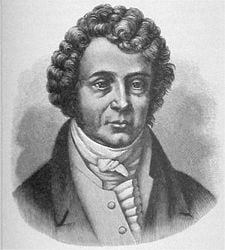André-Marie Ampère
|
André-Marie Ampère | |
|---|---|
 André-Marie Ampère (1775-1836) | |
| Born |
January 22 1775 |
| Died | June 10, 1836 Marseille, France |
| Residence | |
| Nationality | |
| Field | Physicist |
| Institutions | Bourg-en-Bresse École Polytechnique |
| Known for | Ampere's Law |
André-Marie Ampère (January 20 1775 – June 10 1836), was a French physicist who is generally credited as one of the main discoverers of electromagnetism. The SI unit of measurement of electric current, the ampere, is named after him.
Early days
Ampère was born near Lyon, France, and lived from 1782 to 1797 in the nearby burg of Poleymieux-lès-Monts-d'Or. As a child prodigy, he took a passionate delight in the pursuit of knowledge from his very infancy, and is reported to have worked out long arithmetical sums by means of pebbles and biscuit crumbs before he knew the figures. His father began to teach him Latin, but ceased on discovering the boy's greater inclination and aptitude for mathematical studies. The young Ampère, however, soon resumed his Latin lessons, to enable him to master the works of Euler and Bernoulli.
In later life he was accustomed to say that he knew as much about mathematics when he was eighteen as ever he knew; but, a polymath, his reading embraced nearly the whole round of knowledge — history, travels, poetry, philosophy and the natural sciences.
In 1796 he met Julie Carron, and an attachment sprang up between them. In 1799 they were married. From about 1796 Ampère gave private lessons at Lyons in mathematics, chemistry and languages; and in 1801 he removed to Bourg, as professor of physics and chemistry, leaving his ailing wife and infant son (Jean Jacques Ampère) at Lyon. She died in 1804, and he never recovered from her death. In the same year he was appointed professor of mathematics at the lycée of Lyon.
According to the Catholic Encyclopedia, Ampere used to say that "at eighteen years he found three culminating points in his life, his First Communion, the reading of Thomas's "Eulogy of Descartes", and the taking of the Bastille... On the day of his wife's death he wrote two verses from the Psalms, and the prayer, 'O Lord, God of Mercy, unite me in Heaven with those whom you have permitted me to love on earth.' Serious doubts harassed him at times, and made him very unhappy. Then he would take refuge in the reading of the Bible and the Fathers of the Church." [1]
Contributions to physics and further studies
Jean Baptiste Joseph Delambre's recommendation obtained for him the Lyon appointment, and afterwards (1804) a subordinate position in the polytechnic school at Paris, where he was appointed professor of mathematics in 1809. Here he continued to pursue his scientific research and his diverse studies with unabated diligence. He was admitted as a member of the Institute in 1814.
Ampère's fame mainly rests on the service that he rendered to science in establishing the relations between electricity and magnetism, and in developing the science of electromagnetism, or, as he called it, electrodynamics. On September 11, 1820 he heard of H. C. Ørsted's discovery that a magnetic needle is acted on by a voltaic current. Only a week later, on September 18, he presented a paper to the Academy containing a far more complete exposition of that and kindred phenomena.
Legacy and final days
The whole field thus opened up he explored with characteristic industry and care, and developed a mathematical theory which not only explained the electromagnetic phenomena already observed but also predicted many new ones.
He died at Marseille and is buried in the Cimetière de Montmartre, Paris. The great amiability and childlike simplicity of Ampère's character are well brought out in his Journal et correspondence (Paris, 1872). Forty-five years later, mathematicians recognised him.
See also
| Electronics Portal |
- Ampere's Law
ReferencesISBN links support NWE through referral fees
- This article incorporates text from the Encyclopædia Britannica Eleventh Edition, a publication now in the public domain.
Further reading
- Williams, L. Pearce. (1970). "Ampère, André-Marie". Dictionary of Scientific Biography 1: 139-147. New York: Charles Scribner's Sons.
External links
- Ampere and the history of electricity (Correspondence, bibliography, experiments, simulations, etc., edited by CNRS, France)
- Ampere's Museum (CNRS) is in Poleymieux-au-Mont-d'or, near Lyon, France
- John J. O'Connor and Edmund F. Robertson. André-Marie Ampère at the MacTutor archive
- Eric W. Weisstein, Ampère, André (1775-1836) at ScienceWorld.
- Catholic Encyclopedia on André Marie Ampère
| Persondata | |
|---|---|
| NAME | Ampère, André-Marie |
| ALTERNATIVE NAMES | |
| SHORT DESCRIPTION | Physicist |
| DATE OF BIRTH | January 22 1775 |
| PLACE OF BIRTH | Polémieux, Lyon, France |
| DATE OF DEATH | June 10, 1836 |
| PLACE OF DEATH | Marseille, France |
af:André-Marie Ampère bn:আঁদ্রে মারি অম্পেয়্যার bs:André-Marie Ampère bg:Андре-Мари Ампер ca:André-Marie Ampère cs:André-Marie Ampère de:André Marie Ampère el:Αντρέ Μαρί Αμπέρ es:André-Marie Ampère eo:André Marie Ampère fr:André-Marie Ampère fy:André-Marie Ampère gl:André Marie Ampère ko:앙드레 마리 앙페르 hr:André-Marie Ampère io:André Marie Ampère id:André-Marie Ampère is:André-Marie Ampère it:André-Marie Ampère he:אנדרה מרי אמפר lb:André-Marie Ampère lt:Andrė Mari Amperas hu:André-Marie Ampère nl:André-Marie Ampère ja:アンドレ・マリー・アンペール no:André-Marie Ampère nn:André-Marie Ampère pl:André Marie Ampère pt:André-Marie Ampère ro:André-Marie Ampère ru:Ампер, Андре Мари sk:André Marie Ampère sl:André-Marie Ampère sr:Андре-Мари Ампер fi:André-Marie Ampère sv:André-Marie Ampère vi:André-Marie Ampère tr:Andre Marie Ampere uk:Ампер Анре Марі zh:安德烈-玛丽·安培
